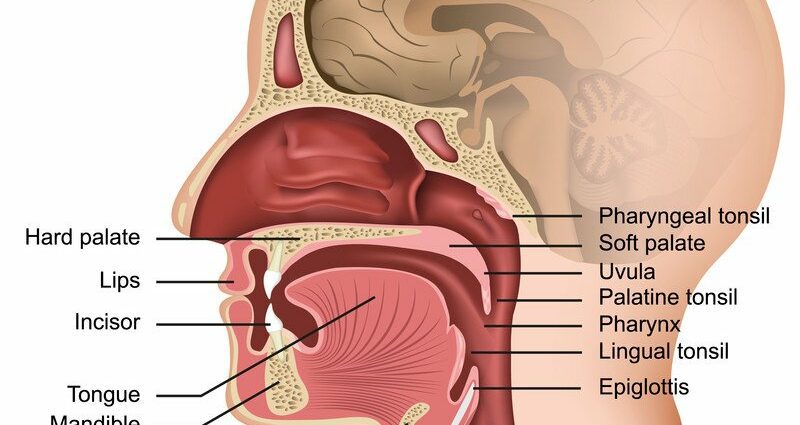Contents
Epiglottis
The epiglottis (from medieval Latin epiglottis, coming from the Greek epiglôttis, meaning “which is on the tongue”) constitutes a structure of the larynx, organ of the respiratory system, located in the throat between the pharynx and the trachea.
Epiglottis: anatomy
Position. The epiglottis is a structure of the larynx. The latter is located after the pharynx, at the level of the separation between the airways (towards the trachea) and the digestive tract (towards the esophagus). The larynx is attached in its upper part to the hyoid bone. The larynx is a duct made up of different cartilages (1), of which five are the main ones: the thyroid cartilage, the arytenoid cartilages, the cricoid cartilage, and the epiglottic cartilage. The cartilages are linked together by a set of ligaments and surrounded by membranes that ensure the rigidity of the larynx. The movement of the larynx is enabled by several muscles which will be particularly involved in the movement of the epiglottis and the vocal cords.
Structure of the epiglottis. The epiglottis is made up mainly of the epiglottic cartilage, forming a heart-shaped relief and giving flexibility to the epiglottis. This cartilage is covered with a mucous membrane. The epiglottis has an upper free edge, and is fixed thanks to:
-
to the thyroepiglottic ligament on its underside; - to the hyoepiglottic ligament on its anterior surface on the hyoid bone (1) (2).
Function of the epiglottis
Role in swallowing. In order to prevent the passage of food or fluids through the trachea and lungs, the epiglottis closes the larynx and the vocal cords come together (3).
Respiratory function. The epiglottis and vocal cords pass inhaled air to the trachea and lungs, and exhaled air to the pharynx (3).
Pathologies of the epiglottis
Sore throat. In the majority of cases, they are of viral origin. In the case of laryngitis or epiglottitis, they may be linked to a bacterial infection.
Laryngitis. It corresponds to the inflammation of the larynx, which can affect the epiglottis. Acute or chronic, it can manifest as a cough and dysphonia (pathway disorders). It is more serious in children and may be accompanied by dyspnea (difficulty breathing) (3).
Epiglottitis. Often of bacterial origin, it is a severe form of laryngitis directly affecting the epiglottis. It can lead to edema of the epiglottis and can lead to asphyxia (4) (5).
Laryngeal cancer. It is generally associated with throat cancer and can occur at all levels of the larynx, especially the epiglottis (6).
Treatments
Antibiotic or anti-inflammatory treatment. An antibiotic may be prescribed for a bacterial infection. Anti-inflammatory drugs may also be prescribed to limit inflammation.
Tracheotomy. In the most serious cases, this surgical intervention consists of an opening at the level of the larynx to allow the passage of air and prevent asphyxiation.
Laryngectomie. In the most severe cases of cancer, removal of the larynx may be performed (7).
Radiotherapy. Cancer cells are destroyed by exposure to x-rays7.
Chemotherapy. Medicines can be given to limit the spread of cancer.
Epiglottis examination
Indirect laryngoscopy. It allows you to observe the larynx, and in particular the epiglottis, using a small mirror placed at the back of the throat (8).
Direct laryngoscopy. The larynx is studied using a rigid and flexible tube introduced through the nose. This intervention can also allow a sample to be taken (biopsy) if the examination requires it (8).
La laryngopharyngographie. This x-ray examination of the larynx can be performed to complete the diagnosis (8).
Anecdotes
valve. The epiglottis is often compared to a valve, preventing food from going astray into the trachea.
Theory on the origin of language. The low position of the larynx in modern humans compared to other mammals was the subject of a theory on the origin of language. However, recent research suggests that the ability to speak is much older (9).










